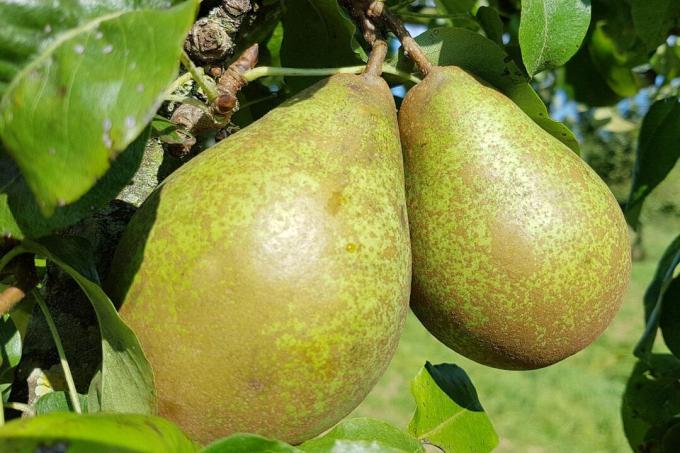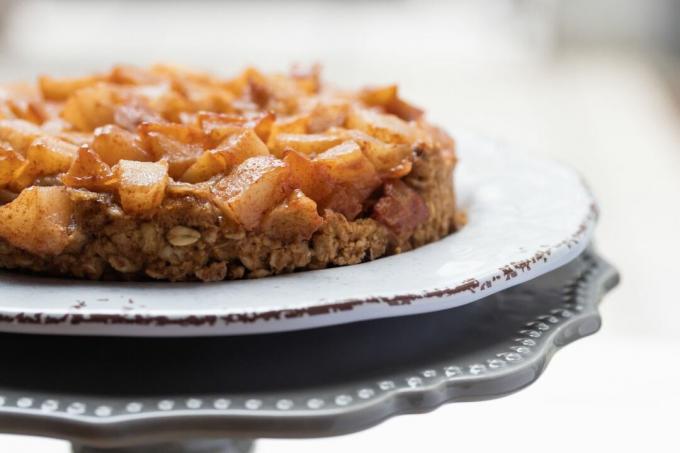The Countess of Paris winter pear is widespread and very popular with professionals. We will tell you everything you need to know about the type of pears in your garden at home.

The 'Countess of Paris' pear already has a long tradition of consumption and cultivation. In good locations with nutrient-rich soil, the very demanding pear convinces with its aromatic and delicately spicy taste. The late-ripening variety 'Countess of Paris' is also convincing because it can be stored for a long time and can be planted as a small tree.
contents
- Pear 'Countess of Paris': wanted poster
- Origin and history of the 'Countess of Paris' pear variety
- Characteristics and taste of the pear
- Plant and care for the Countess of Paris pear tree
- 'Countess of Paris' pear: harvest time and storage
Pear 'Countess of Paris': wanted poster
| synonyms | 'Comtesse de Paris' |
| fruit | Medium to large, typically elongated pear shape |
| the taste | Sweet, spicy, aromatic |
| yield | Regular, high to very high |
| harvest time | October to November |
| maturity | mid-November to January |
| shelf life | Until January, occasionally even longer |
| growth | Medium strong, even |
| climate | Warm and wind-protected locations |
| diseases and pests | Slightly susceptible, susceptible to scab in some areas |
Origin and history of the 'Countess of Paris' pear variety
The Countess of Paris pear was selected from wild seedlings by gardener William Fourcine in France around 1884. In 1889 it was first mentioned in a French horticultural journal. A short time later, the variety was also in demand outside of France due to multiple mentions - including in German literature. Today it is distributed from Europe to western Asia.
Characteristics and taste of the pear
The ripe pears of the 'Countess of Paris' variety delight with their sweet, juicy, melt-in-the-mouth taste. On the tongue, this develops in the direction of a finely spicy, slightly acidic finish. The fruits are medium to large in size, oblong and typically pear to cone shaped. They often have a constriction towards the stem and end with a narrow crest. The shell is greenish to yellowish and rusty. This can also be somewhat rough and have numerous shell points. The flesh of the Countess of Paris pear is yellowish-white and often somewhat grainy. In unfavorable locations, such as those that are too cool, there is a risk of stone cell formation and a loss of aroma on the pears.

Plant and care for the Countess of Paris pear tree
Characteristic of the 'Countess of Paris' pear tree are the expansive, slightly conical or pyramid-shaped crown and the evenly appearing, short fruit wood. With this pear variety you can choose from a variety of forms: The 'Countess of Paris' can be raised as a half-stem or standard on seedling rootstock. Quince, such as quince C, can also be used as a base for smaller trellis trees. Between March and October you can Plant a pear tree.
In the period from January to April or June to August you can also Pruning pear treeto keep getting a bountiful harvest. The 'Countess of Paris' grows upright, but forms a well-garnished crown without you having to do anything. Excessive pruning should be avoided with this strain, however. Older trees should occasionally be pruned more heavily for rejuvenation to provoke new fruiting wood.
The flowering of the 'Countess of Paris', which begins as early as April, beautifies your home garden early with its spring-like flora. In autumn, the 'Countess of Paris' pear tree, with its bright orange-yellow leaves, is also a striking gem in your garden. Like all pear varieties, the 'Countess of Paris' is a cross-pollinator and therefore dependent on the presence of pollinating pears in the vicinity. Other early flowering varieties such as Countess of Paris are preferred pollinators 'Bosc's Bottle Pear', ‘Gellert’s Butter Pear’,‘Delicious from Charneuex’, 'Williams Christ' and 'Madame Verté', possibly also 'Clapps Liebling', 'Early von Trevoux', 'Josefine von Mechelen' or 'Bunte Julibirne'.

If you want to achieve the highest possible yields with your 'Countess of Paris' pear, a sunny and wind-protected location is suitable. Also important is a very nutrient-rich, deep soil, which can be loamy, sandy or humic. Sandy soils must be watered when dry. Since the variety does not tolerate waterlogging, deep loosening and drainage before planting is essential on loamy soils. In cool fruit-growing areas, the 'Countess of Paris' is only suitable as a trellis on house walls that face the sun. Occasional fertilization with a long-term fertilizer rich in potassium - for example ours - is important to ensure the supply of nutrients via the soil and to ensure that the pears are of good quality Plantura organic universal fertilizer - a good addition. This is particularly useful on sandy and nutrient-poor soils.
The 'Countess of Paris' variety is highly susceptible to the bacteriosis fire blight, which fortunately is quite rare. On humid locations and heavy soil, pear scab can become a problem. It also tends to form frost plates, but is otherwise quite frost hardy.
'Countess of Paris' pear: harvest time and storage
The Countess of Paris harvest season begins around mid or late October, sometimes as late as early November. The fruits are now ready to be picked and develop their full flavor after four to six weeks of storage. However, ‘Countess of Paris’ pears harvested unripe can become tough in storage. The pear variety 'Countess of Paris' is particularly characterized by its long shelf life until January or even longer. A cool, unheated cellar is ideal for storing the Countess of Paris pear. Heavily rusted fruits should be consumed or processed as soon as possible, otherwise they will quickly shrivel and become inedible.

In the kitchen, the 'Countess of Paris' pear is a true all-rounder, because with its pronounced sweet-aromatic taste and slightly spicy finish, it is suitable for both for direct consumption as well as for a variety of processing, for example in cakes, as an accompaniment to savory dishes or for preservation by boiling or withering
If you know more about the best traditional and new pear varieties If you want to know more, you can read on in our overview.



